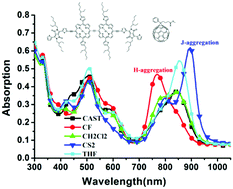Improving the efficiencies of small molecule solar cells by solvent vapor annealing to enhance J-aggregation†
Abstract
We report highly efficient small molecule organic solar cells (SM-OSCs) based on a porphyrin derivative electron donor of ZnP2-DPP and an electron acceptor of [6,6]-phenyl-C61-butyric acid methyl ester (PC60BM) by using a solvent vapor annealing (SVA) method with a series of low boiling solvents. Absorption spectral studies indicate that carbon disulfide (CS2) SVA induces J-aggregation in blend films accompanied by expanded and enhanced absorption which contributes largely to the fabrication of broader light response and larger short-circuit current (JSC) solar cell devices. In addition, we systematically analyze the relationship between the film morphology and device performance. Finally, the electronic study shows that the CS2 SVA-treated device showed a higher exciton generation rate and enhanced carrier collection efficiency. And the morphology study indicates that the blend films treated with CS2 SVA exhibit tighter molecular packing, better crystallization and an appropriate phase separation length scale. In other words, these collective electronic and morphological features correlate well with the champion JSC, the fill factor (FF) and the power conversion efficiency (PCE) of the CS2 treated devices.



 Please wait while we load your content...
Please wait while we load your content...